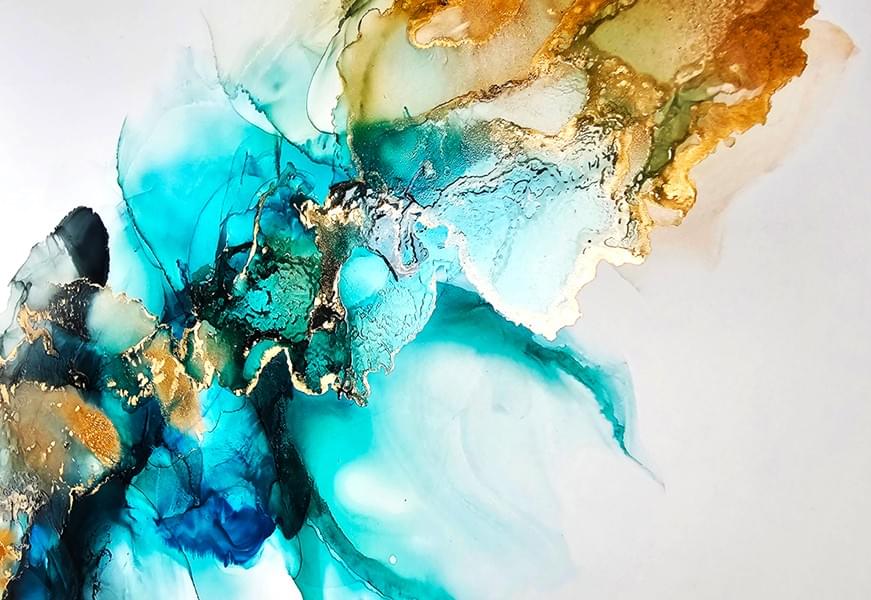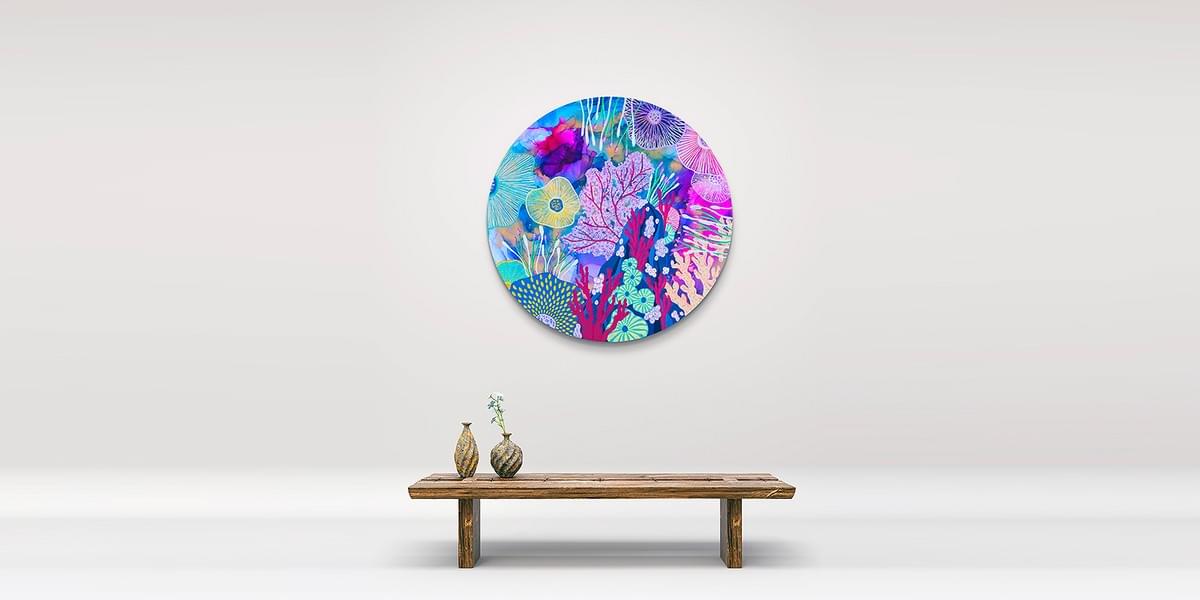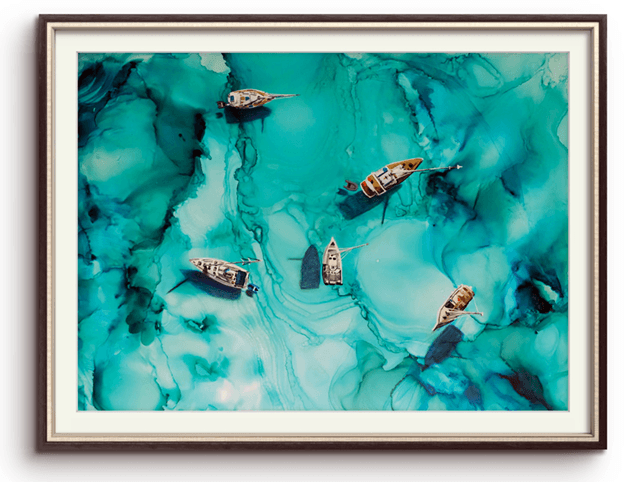A Mindful Journey into Alcohol Ink Painting : 2
A Mindful Journey into Alcohol Ink Painting : 2
My Guide to Alcohol Ink Abstract Art - Part 2

Original Alcohol Ink Abstract Art - A Guide by Artist Andrea Dell : Art in progress by Andrea Dell
This page is part of a series of Andrea Dell's bite-sized guides in which you will discover the captivating world of alcohol ink art - created for both buyers to understand more about the technique as well as artists seeking to explore the ink medium further.
- Introduction: Unveiling the Vibrant World of Alcohol Ink Art
- About Abstract Art: The Mesmerising Flow of Alcohol Inks
- The Essential Toolkit: Materials and Supplies for Alcohol Ink Artistry
- Unleashing Creativity: Mastering Alcohol Ink Art Techniques
- Beyond the Brush: Exploring Styles and Themes in Alcohol Ink Abstract Art
- Nurturing Your Masterpiece: Safety, Sealing, and Preserving Alcohol InkArt
- Frequently Asked Questions About Alcohol Ink Abstract Art
In this section you will learn about alcohol ink materials and supplies needed, plus an introduction to alcohol ink techniques
The Essential Toolkit - Materials and Supplies for Alcohol Ink Artistry
The Alcohol Inks Themselves: Colours and Quality
Artists need a variety of colours to start, looking for high-quality inks that offer vibrant pigments and good lightfastness. Some brands are known for their rich hues and performance.
A special mention goes to white ink. It is often pigment-based and opaque, unlike other transparent dye-based inks. It is fantastic for creating pastel shades or unique effects when mixed, adding a creamy, ethereal quality to designs.
The Magic Mixers: Blending Solution and Isopropyl Alcohol
The alcohol blending solution is an artist's best friend for diluting inks, creating smooth blends, and softening edges. It helps control the ink's movement and slows down drying slightly, giving the artist more time to manipulate their designs.
Isopropylalcohol (IPA), often 90% or higher, acts as a solvent to create unique textures, dilute pigments for matte finishes, and reactivate dried ink. It can also be used for cleaning up messes, making it a versatile addition to any studio! While rubbing alcohol (mostlyisopropanol) can work, dedicated blending solutions often provide better results with a slight sheen, offering a more professional finish.
The choice between alcohol blending solution and isopropyl alcohol is a strategic one, as they are not interchangeable in their effects. Blending solution, with its specific composition, offers superior blending and a subtle sheen, ideal for smooth transitions and luminous effects. Conversely, pure IPA is better for
diluting pigment, creating matte finishes, or reactivating dried layers. This distinction allows artists to achieve a wider range of intentional effects and precisely control the final look of their abstract art, moving beyond random application to a more informed and deliberate practice.
The Canvas: Choosing Your Non-Porous Surface
Alcohol inks shine on non-porous surfaces because they do not get absorbed, allowing the inks to flow and move freely across the material.
Synthetic papers are a top choice for both beginners and experienced artists alike, due to their durability, smooth finish, andbright white colour. It is waterproof and perfect for allowing inks to glide and blend.
But we do not limit our creativity! Artists also experiment with other non-porous surfaces like ceramic tiles, glass, metal, acrylic sheets, and even plastic sheets. Each surface offers a slightly different feel and can inspire new creative directions.
Tools of the Trade: Applicators and Manipulators
Artists need brushes and applicators. Synthetic brushes or felt applicators offer control and precision, allowing for deliberate strokes and detailed work. Cotton rounds or buds can also be used for swiping and creating softer, blended areas.
For moving the ink, air movement tools are crucial. Straws, air blowers, compressed air, or even a hairdryer (those with low heat and air settings, under 600W, are often best) are invaluable for pushing the ink around and creating dynamicpatterns. Imagine blowing gently through a straw and watching the colours dance!
Finally, protective gear – you should always wear gloves, as alcohol inks are highly pigmented and can stain hands quite effectively. No one wants rainbow fingers for days!

Original artwork by Andrea Dell. Acrylic on alcohol ink on a circular canvas.
Unleashing Creativity - Mastering Alcohol Ink Art Techniques
Getting Started: The Fundamentals
Beginning with alcohol inks is an exciting journey. One fundamental technique is Drop and Tilt. Simply drop ink onto the chosen surface, then gently tilt it to let the ink spread naturally. Add complementary or contrasting colours to the wet ink and watch them mingle.
Another basic is Dropping and Blending. Apply ink, then add isopropylalcohol or blending solution to dilute it and create different shades and softer transitions. This allows for a beautiful gradient effect.
For dynamic movement, use Air Power. A straw or air blower can move the ink around, blending colours and creating abstract patterns. Even a gentle puff of air changes how the ink moves, creating delicate tendrils or bold sweeps of colour.
Building Depth: Layering and Reactivation
Alcohol inks are translucent, which means layering different colours creates incredible depth and dimension in artwork. The key is patience: allow each layer to dry completely before adding the next to avoid muddying the colours.
Remember, artists can reactivate dried layers with alcohol to create new textures and blend them into fresh ink. This is a fantastic way to salvage or add complexity to older pieces, giving them a new lease on life. This iterative approach to alcohol ink art is a significant advantage. The ability to layer and reactivate means that a piece is rarely 'finished' in a single session. This fosters a process-oriented approach, where artwork can evolve over time, reducing the pressure of immediate perfection. This continuous evolution encourages resilience and learning, allowing for deeper exploration of creative ideas and the development of complex, multi-layered abstract art pieces. It transforms potential 'mistakes' into opportunities for further creative exploration.
Advanced Manipulations: Beyond the Basics
Once comfortable with the fundamentals, artists can explore more intricate techniques. The Alcohol Lift Technique involves applying ink, letting it dry, and then using a clean cloth or cotton swab dipped in isopropyl alcohol to 'lift' ink away, creating intricate designs or highlights. It is lIke drawing with subtraction !
Masking involves using masking fluid or stencils to protect certain areas of the surface, then applying ink around them. Once dry, removing the masking reveals untouched surfaces, creating crisp, defined shapes.
For more deliberate compositions, Controlled Pouring allows artists to guide the ink flow by tilting the surface to create specific shapes and patterns. This requires a steady hand and a clear vision.
Heat Tools, such as embossing heat guns or hairdryers, can speed up drying and manipulate ink, creating interesting textures and cellular effects. The heat causes the alcohol to evaporate faster, pushing the pigments in unique ways.
Finally, alcohol inks play well with others! Combining with Other Mediums like acrylics, resin, or markers can add more dimension and texture to artwork. For the truly adventurous, fire can even be used with caution on ceramic or glass for unique, dramatic effects.

'Drop Anchor' - Original Painting by Andrea Dell. Alcohol ink and acrylic pen on synthetic paper

